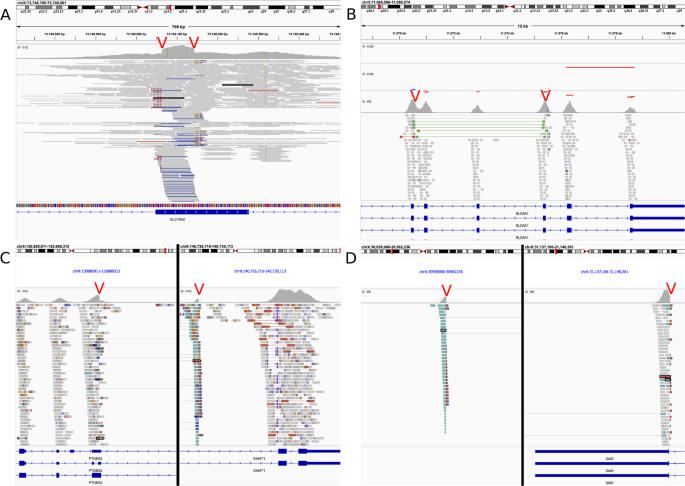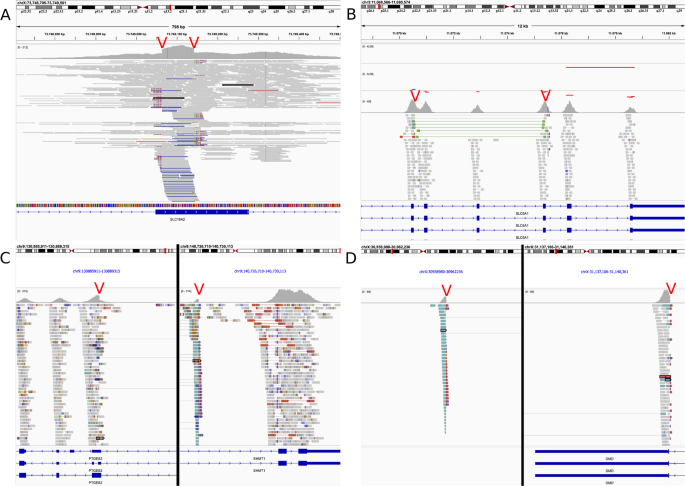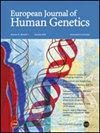6224 个未解决的罕见病外显子组的结构变异调用和临床解读。
IF 3.7
2区 生物学
Q2 BIOCHEMISTRY & MOLECULAR BIOLOGY
引用次数: 0
摘要
结构变异(SV),包括大的缺失、重复、倒位、易位和更复杂的事件,都有可能破坏基因功能,导致罕见疾病。然而,目前用于外显子组测序(ES)的流水线和临床决策支持系统往往侧重于单核苷酸变异(SNV)和短于 50 个碱基对的插入-缺失(indels)等小变异。此外,大型拷贝数变异(CNV)的检测和解释也经常进行。然而,在 ES 数据中检测其他类型的 SVs 时,由于难以确定非靶区(基因间或基因内)的断点,使得 SVs 的稳健识别面临挑战。在本文中,我们展示了在 ES 中进行 SV 调用的实用性,结果显示,在 Solve-RD 联盟收集的一大批未解决的患者中,SV 的诊断率为 0.4%(5825 个概率中的 23 个)。值得注意的是,在 23 个致病 SV 中,有 8 个在基于深度阅读的 CNV 综合分析中未发现,因此诊断价值提高了 0.13%。本文章由计算机程序翻译,如有差异,请以英文原文为准。


Structural variant calling and clinical interpretation in 6224 unsolved rare disease exomes
Structural variants (SVs), including large deletions, duplications, inversions, translocations, and more complex events have the potential to disrupt gene function resulting in rare disease. Nevertheless, current pipelines and clinical decision support systems for exome sequencing (ES) tend to focus on small alterations such as single nucleotide variants (SNVs) and insertions-deletions shorter than 50 base pairs (indels). Additionally, detection and interpretation of large copy-number variants (CNVs) are frequently performed. However, detection of other types of SVs in ES data is hampered by the difficulty of identifying breakpoints in off-target (intergenic or intronic) regions, which makes robust identification of SVs challenging. In this paper, we demonstrate the utility of SV calling in ES resulting in a diagnostic yield of 0.4% (23 out of 5825 probands) for a large cohort of unsolved patients collected by the Solve-RD consortium. Remarkably, 8 out of 23 pathogenic SV were not found by comprehensive read-depth-based CNV analysis, resulting in a 0.13% increased diagnostic value.
求助全文
通过发布文献求助,成功后即可免费获取论文全文。
去求助
来源期刊

European Journal of Human Genetics
生物-生化与分子生物学
CiteScore
9.90
自引率
5.80%
发文量
216
审稿时长
2 months
期刊介绍:
The European Journal of Human Genetics is the official journal of the European Society of Human Genetics, publishing high-quality, original research papers, short reports and reviews in the rapidly expanding field of human genetics and genomics. It covers molecular, clinical and cytogenetics, interfacing between advanced biomedical research and the clinician, and bridging the great diversity of facilities, resources and viewpoints in the genetics community.
Key areas include:
-Monogenic and multifactorial disorders
-Development and malformation
-Hereditary cancer
-Medical Genomics
-Gene mapping and functional studies
-Genotype-phenotype correlations
-Genetic variation and genome diversity
-Statistical and computational genetics
-Bioinformatics
-Advances in diagnostics
-Therapy and prevention
-Animal models
-Genetic services
-Community genetics
 求助内容:
求助内容: 应助结果提醒方式:
应助结果提醒方式:


